
Neural Networking, Neural Networks, AI, AxI in Lottery, Lotto: Prediction Strategies, Systems, Software, History
★ ★ ★ ★ ★
By Ion Saliu, Founder of Axiomatic Intelligence (AxI)



The probability problem many persons still have is the overlapping of contradicting concepts: Certainty and Randomness. Everything is random, inquisitively axiomatic ones, indeed, the Universe. The_Everything comes in degrees of certainty. Various degrees of certainty determine various degrees of randomness.
The confusion goes further by using a fancy concept: Neural networking. Even fancier: Artificial intelligence (AI). In fact, all those theories do one thing. They try to find relations between elements of a system, relations that took place in the past. From those past relations (more accurately named stats), this type of theories (AI, etc.) try to predict future relations between the same elements.
Methinks it all this fancy stuff started with the Markov Chains theory. That theory is simplistic, however. It bases the analysis on a reduced number of elements that have higher degrees of certainty DC to occur. The system (container) of such elements is considered non-random. Again, contradiction in terms, as everything is random, mathematically proven beyond reasonable doubt.
And that explains why you hear crying-out-loud: "Neural networking, artificial intelligence AI cannot be applied to lottery, because the lottery is totally (?) random!"
Well, I got good news for you. "Neural networking" does work with the lottery as far as more successful prediction is possible based on statistics (what happened in the past). If you stay here, you can read (and surely replicate) a case where neural networking applied to a lotto game beat random play by a factor of 37. Yes, the "AI" prediction strategy was 37 times better than simply selecting lotto numbers randomly!

Inquisitively axiomatic ones, you are right and wrong about this one thing. Indeed, I've never mentioned neural networking as one of my lottery strategies or methods. On the other hand, I might as well be the first individual to apply such a method to lottery games. I was an [idle] economist in the early 1980s in Communist Romania. I did it for two other economists with the expectation they would share the winnings with me — without asking me to participate financially (it wasn't even much!)
I did it again in 1985 soon after I was resettled as a refugee to the United States. I was shortchanged again, but not as badly as in Romania!
I did write briefly about the two (actually, three) events: Jackpot Lottery Strategy: 12-Number Combinations, Lotto-6 Wheels, Pioneer Software.
I pretty much abandoned the neural networking method because of the lotto wheels. I am not a fan of the lotto wheels as they aim at lower-tier prizes — and they prevalently achieve that goal. Therefore, the lotto wheels deprive the player of winning the lotto jackpot in an overwhelming majority of situations. Mind you, the 9-number and 12-number lotto-6 wheels I applied are absolutely the best regardless of game format. The 2 lotto wheels are capable of the highest leverage in this regard. Ultimately, they have the highest degree of certainty (chance) to hit even the jackpot!
In Computerland USA I devised a totally new lottery strategy: Eliminate groups of numbers (patterns) from previous lottery drawings. The [personal] computer would take care of the entire process — no more the error-prone "paper-and-pencil" tedium. I expanded the elimination (or filtering) method way up to the... ionosphere, as a few pundits put it!
Then, back to the future again... the neural networking strategy. During the hot summer of the year of grace 2018 — and while watching the FIFA World Cup hosted by Mother Russia and Trump's Father-Figure Putin — I came up with a new idea of generating lottery combinations. The numbers, especially in jackpot lotto games, should be weighed based on their frequency. For example, I generate the frequency reports (as in my 6/49 game in the Pennsylvania Lottery).
My 6-49 lotto drawings file is named PA-6. The first test of this nature was published in the Google group dedicated to the lottery: Odds Calculator, Number Combination Generator for Lottery, Lotto, Powerball, Mega Millions, Euromillions. There is a lot of stuff in that thread... just scroll down to the posts dated July 23, 26, 2018.
The last drawing in the file was 2 20 26 32 44 46 (7/22/2018). The parpaluck (range of analysis, or number of draws to do the reporting for) is very important. I set it to 25 or half of total numbers in the lotto game. It proves to offer the best winning ratio for the derived lottery systems. Here you have the reports created by that great piece of lottery and gambling software b.k.a. FrequencyRank —

The statistical (frequency) reports are of the essence. Generating the reports is a breeze… provided that they are done by computers running the right software.

The lotto numbers sorted by frequency, from the hottest (most frequent) to the coldest (least frequent)
24 38 10 20 21 1 30 9 41 26 2 31 34 35 36 12 13 42 46 33 14 16 25 17 39 19 3 43 32 47 49 29 8 40 4 15 6 7 18 27 5 44 45 23 37 28 11 48 22

The lotto numbers sorted by frequency, from the hottest (most frequent) to the coldest (least frequent) in the respective position
I created strings consisting of the lotto numbers with the best frequency rankings. I selected the top-35 lotto numbers for frequency regardless of position. Positional analysis: I selected only the lotto numbers with frequency larger than zero in each position. Total possible combinations Regardless of Position is close to total possible combinations in Positional style.
24 38 10 20 21 1 30 9 41 26 2 31 34 35 36 12 13 42 46 33 14 16 25 17 39
1 2 10 4 7 9 3 6 8 12 20 24
13 12 9 14 21 24 5 6 8 15 16 19 20 3 10 26 27 31
24 19 16 25 30 32 17 18 10 20 21 12 13 26 27 14 9 34
30 24 20 31 34 23 17 25 26 28 29 18 15 32 33 21 35 38 41
36 38 40 42 31 33 34 35 17 37 21 39 24 41 29 43 44 46
41 46 47 49 42 43 38 39 35 26 33 45
Axioman/axiowoman, those two systems do hit the jackpot within 30 drawings in a 6/49 lotto game! The best software for the task of checking winning numbers is another great piece of lottery software: Super Utilities, main menu of Bright / Ultimate Software, function W = Check for Winners. The software offers multiple options, including groups (pools) of numbers. The player doesn't have to generate combinations first, and then check them for winners against real lottery draws. You can check the groups directly, axio. It is very fast that way. The 2 20 26 32 44 46 draw was followed by 34 drawings in my analysis. You can replicate this study any time, in any lotto game, with any lottery drawings. My data files are virtually totally accurate (they do not include the infamous pre-test drawings the lotteries worldwide are... infamously notorious for!)

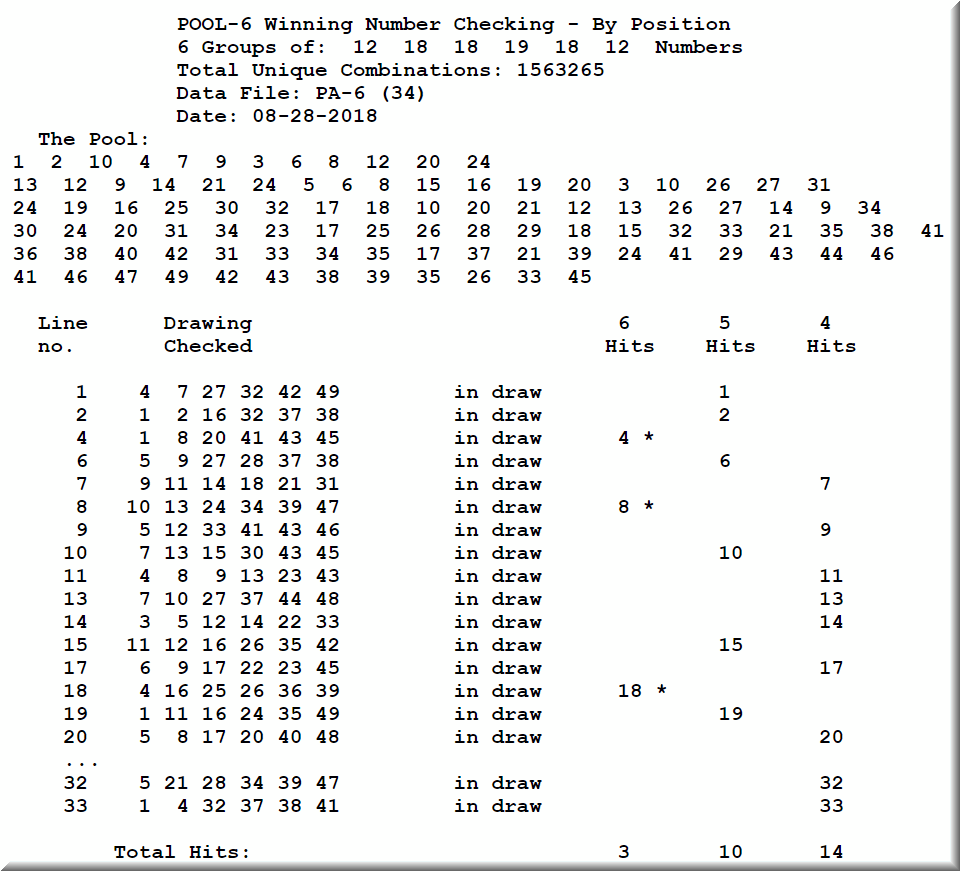
YES! The lotto jackpot is there 3 times! I also checked how the top-25 numbers fared. You might have seen Gaitsa's lotto strategy based on playing the top-half of the lotto numbers based on frequency. I always give credit where credit is due, including to a pioneer in the lottery field named Gail Howard. The weakness of her methodology was the parpaluck. She did the analysis for all drawings in the game, even regardless of game format!
"That's bad and sad... tremendously bad," the same Donald Caligula Trump Trump (gotta be at least the power of 2) would tell you in private (please don't record him secretly... I'd never do that — ever!) In other words, Gail Howard did the frequency report by combining all formats of the game. For example, when I came to the United States, the game I played in Pennsylvania was 6 of 40, then it changed to 6/48, and then to 6 of 69 and currently 6 of 49. I work now only with a data file (results or real-drawings) for the 6 of 49 game. And, as you have noticed by now, I never use all drawings in the file as the parpaluck.
So, I performed a non-positional analysis for the top-25 lotto numbers based on frequency. Here is the winning report:

Again, the lotto jackpot was there within 30 drawings. In Romania, the AI (neural networking) strategy hit right away, in the very next drawing. In that situation, I selected 12 lotto numbers based on frequency and pairing. The 12-number super lotto wheel I applied also hit 6 of 6 immediately. In the 1985 Pennsylvania cases, I selected only 9 numbers (amount determined by budget restrictions). I did pick correctly 5 of 6 winners in both situations. The 9-number lotto wheel I played offered the 4 of 6 prize (actually, the minimum assurance was 4 of 5).
No doubt, my neural networking strategy hits the jackpot. However, I don't think the degree of certainty DC is high enough. Therefore, I applied this form of Artificial Intelligence (AI) as my proprietary (and by now famous) LIE Elimination Lottery Strategy. I did change my mind this 2018 Summer nonetheless. Just look at that system consisting of 177100 combosnations (a favourite term in my lottospeak!) It beats the odds by a factor of 2. Can your system do better? NOT!! Not to mention, the system gave you 5 second-tier prizes and 6 third-tier payouts — while waiting for that grandiose jackpot we all dream about!
Selecting the lotto numbers by frequency AND pairing reduces the numbers to play and increases the system efficiency by orders of magnitude. Granted, one would have to wait a little longer for fruition. But I know you are mindful: Winning just one jackpot is enough — it is a life-changer!

They say AI (artificial intelligence) or neural networking is about learning. That is, software programs "learn" from the past. In lottery, the Markov Chains theory is also about "learning". In what I present on this page, it is more about human learning. I checked the number frequencies and I determined that certain elements showed better appearances in the recent lottery drawings (recent past). I can do also a pairing analysis and a triplet (3-number groups) analysis. I can select the "best" lotto numbers to play for each type of analysis. Or, I can combine the two analyses and come up with numbers that might have a better chance to win in the near future. I did just that. The software in the image above can do many types of numeric analyses.
The pairing report has the best lotto pairs at the top.

I put the best pairings together so that I get 12 lottery numbers to play (thinking also of applying that super lotto wheel).
Next, I checked for winners as I did here for individual (single) numbers.
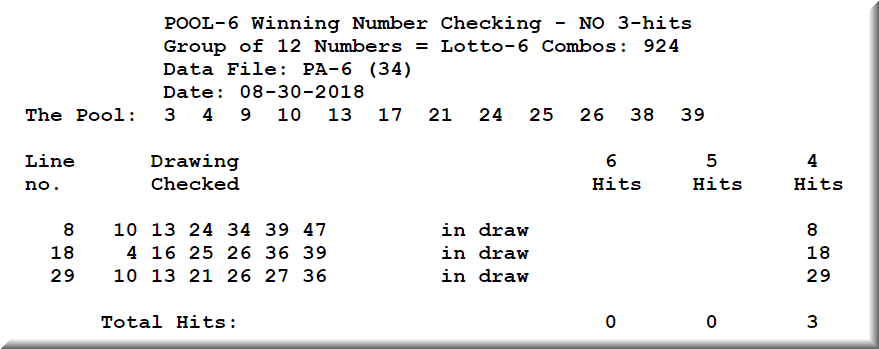
Wins: three 4 of 6 hits.
The triple report has the best lotto triplets at the top.
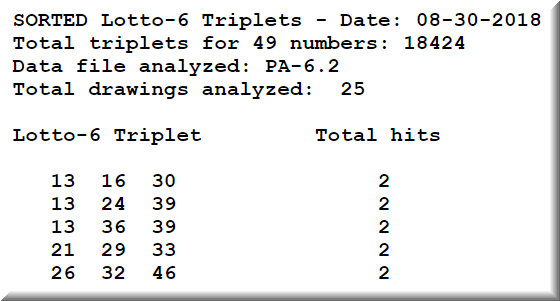
I put the best pairings together so that I get 12 lottery numbers to play (thinking also of applying that super lotto wheel).
Next, I checked for winners as I did here for the pairings.
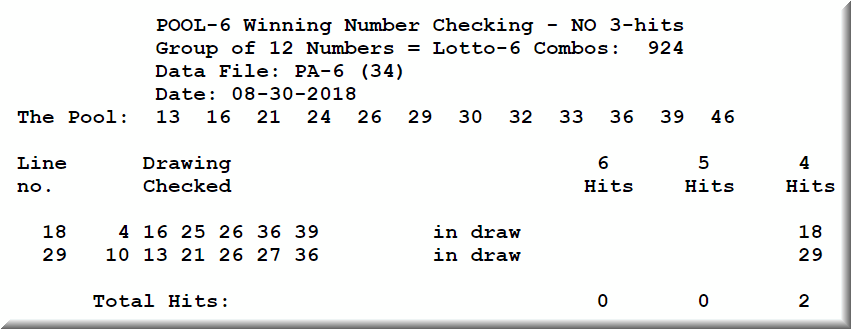
Wins: two 4 of 6 hits.
Here is the interesting thing. I put together the lotto numbers in the pairing pool and the triplet group. This time, I wanted a total of 18 numbers to apply another great lotto wheel (also available at this site and presented earlier on this page).
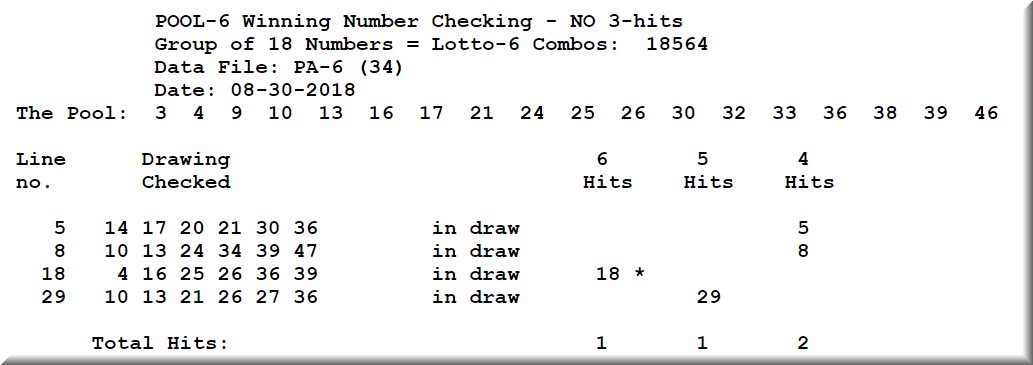
The winning is fantastic in this situation: 22 times better than random play! Since the jackpot win came within 20 drawings, the success ratio is even better. It beats random play by a factor of 37. Evidently, there is no guarantee that the wheel would render the jackpot combination in the situation the pool of numbers did hit the jackpot. The excellent lotto wheel for 18 numbers in 51 lines only guarantees 4 of 6 minimum. Hence, my reticence toward lotto wheels! It must be frustrating to have all 6 winners in your pool... and lose the lotto jackpot!
I also reinforce the idea of my proprietary LIE Elimination (or Reversed Lottery Strategy). As you can see in the reports, none of the system hit a 4 of 6 in the very next drawing (in draw 34). I would LIE Eliminate the combinations from all these systems created here applying an aggressive LieID=4. I won't go wrong even going with the same combinations for the next 5 draws.

All the above neural networking deals with lottery outcome in lexicographical order. There is also the other side: random combinations. Instead of generating all the combinations in lexicographical order, the player has the option of generating random combinations. I just checked all my software library — it is HUGE! There is plenty of software that generates lottery combinations in lexicographical order from groups of numbers — either regardless of position or positional strings. The best known application is probably SkipSystem, function G: Generate Combinations from Systems. The app can generate combos from any strings of numbers, not only the FFG systems it creates.
As for random combinations, I could only find two programs: Range-5 and Range-6. They are part of the Ultimate Software packages, the 5- and 6-number lotto games only. I thought of upgrading the all-encompassing Skip System. It would be of great service especially to players of the humongous-odds games Powerball/Mega Millions/Euromillions games. Problem was, that magnificent application would grow way too big for a command-prompt software program.
As you read in the Google group I referred you to, I've had the brilliant idea of generating random lotto combinations from strings of weighed lotto numbers based on their frequencies. As I showed in the thread, playing 100 combos assures, on average, 2+ hits winning 3 of 6/49 prizes. I know, it isn't much... but there are good chances at the jackpot. As you can see, each lotto number appears as many times as its frequency. For example, lotto #1 hit 5 times within the parpaluck (draw range). Therefore, #1 is listed 5 times in its respective position. The more times a number is listed, the higher the chance it will be drawn by the random number generator (as the ones I created for picking values from a list or string of numbers).
At this time of writing, however, my lottery neural networking theory can be applied manually only. Writing software isn't a walk in the park, axios! (Yes, it's me who created all those concepts derived from axiomatic: axio, axios, axiomatics. But I do not claim copyright protection for them, or for the royalty-names I create and grant to all sorts of persons. In my book, axiomatic means undeniably truthful.) I always announce new software titles (updates too) on the New Writings you can see on all footers.

I challenged the advocates to take a small step and "improve" or "take further" any of my lottery strategies. Or, any task their "neural net" software might have and learn a simple fact I would ask. Of course, the artificial intelligence or neural networking software is incapable of any such feats without proper implementation of special algorithms.
In the case of the lotto strategy you see right above this section, I would have loved computers (or anybody else's software) to take me one step further. That didn't happen, because my software didn't have the specific algorithms. So, what I did is I followed the very first AI methodology I started this article with. I used my natural intelligence again. Nothing artificial, albeit I took advantage of my artificial aides (computers, that is) as if they were "workhorses".
Users of my lottery software had similar ideas years ago, soon after I went public with my lottery theories and programs. I have always stressed that repeating the process of generating random numbers increases the degree of certainty of hitting the jackpot combination. And that is true even in the case of my free random-number generators. In the case of my random-generating programs that employ filters, however, the degree of certainty is higher by factors of magnitude.
I remember one software user wrote to me something along these lines: "Hey, Parpaluck, axiomatic one! I applied a few safe filters in your program and let the soft run for a few hours [the computers were far slower back in the day]. I noticed several repeating combos in a run of around 5000 combinations. Curious thing, there was a jackpot winner amongst the repeated combos!"
The user of my lottery software simply discovered the... discovery using his own intelligence, not "artificial intelligence". Nonetheless, his computer did help him in his discovery. Only the computers can generate millions of lotto combinations in a reasonable time, while filtering out unwanted millions of lines (impossible-to-play tickets). Then, the computers can check for winners in a very short time.
Everybody can use my totally-free random lotto combinations generators — both online (Internet Explorer only) and off-line. A module can generate 1000 combinations (lines) at a time. You can select all lines in the textbox and save to a text file (you can use Notepad++ for the task). You can repeat the procedure some 100 times (takes a few minutes) and save to the same text file by appending (until you get some 100,000 lines).
At this point, you can employ another great freebie: CMSort. It works at the command prompt. Use the setting D=Duplicate1.file. The small app will sort the text file you saved in Notepad++, will remove the duplicates, and will save the duplicates to D=Duplicate1.file. When you open that file again in Notepad++ you will notice that some combinations repeat more than once. You can repeat the CMSort procedure several times. Say, you want to play only the lotto combinations that repeated 5 times or more. Thusly, sort D=Duplicate1.file and save the 2+ repeats to D=Duplicate2.file, etc. The more times a combination repeats, the higher its chance to win.
Evidently, my registered software works better by orders of magnitude since it applies a plethora of filters. Still, even the free case-scenario above does offer players better chances at hitting the jackpots. In the case of humongous-odds lotto games (Powerball, Mega Millions), repeat the generating procedures maybe 1000+ times. It takes a while, but then you can play the same sets of repeated combinations for longer periods of time (lottery drawings). You should check that none of the free repeated combinations had a jackpot win in the history of your game of choice.
“Believing in artificial intelligence (AI) literally is like getting drunk with illusions (ILL) metaphorically.” – Ion Saliu, 3:14, 6:18.


Home | Search | New Writings | Fundamental Formula | Odds, Generator | Contents | Forums | Sitemap
